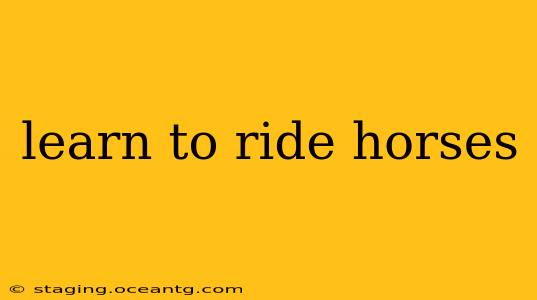Learning to ride horses is a rewarding experience, offering a unique connection with nature and a thrilling sense of freedom. However, it requires patience, dedication, and proper instruction. This comprehensive guide will walk you through the essential steps, addressing common questions and concerns along the way.
What are the first steps to learn to ride a horse?
The very first step is finding a reputable riding school or instructor. Look for a facility with well-maintained horses and experienced instructors who prioritize safety. They should offer beginner lessons tailored to your skill level, starting with the basics of horse handling and safety procedures. These initial lessons typically focus on:
- Groundwork: Learning how to approach, groom, and handle a horse safely. This includes understanding their body language and how to lead and control them on the ground.
- Mounting and Dismounting: Mastering the safe and efficient techniques for getting on and off the horse. This involves using the mounting block and maintaining balance.
- Basic Riding Positions: Learning the correct posture, including how to sit, hold the reins, and use your legs for balance and communication.
- Basic Gaits: Starting with the walk, learning to maintain balance and control at this slow pace. As you progress, you'll learn to transition to the trot and canter.
How long does it take to learn to ride a horse?
There's no single answer to this question, as it depends entirely on individual aptitude, the frequency of lessons, and the quality of instruction. Some individuals might feel comfortable cantering within a few months, while others may require longer. Consistency is key; regular lessons and practice are far more effective than sporadic sessions. Think of it as learning any new skill – it takes time and dedication to master. Focus on building a strong foundation in the basics before progressing to more advanced techniques.
How much does it cost to learn to ride horses?
The cost varies greatly depending on your location, the type of facility, and the frequency of lessons. Expect to pay anywhere from $30 to $100 or more per lesson. Some riding schools offer package deals for multiple lessons, which can be more cost-effective. Additionally, you'll need to consider the cost of equipment, which may include riding boots, a helmet (crucial for safety!), and possibly riding breeches or other suitable clothing.
What should I wear when learning to ride a horse?
Safety and comfort are paramount. Always wear a riding helmet that meets safety standards. Long pants are recommended to protect your legs from chafing and potential injury. Avoid loose clothing that could get caught in the saddle or stirrups. Comfortable, closed-toe shoes with a small heel are preferable; sneakers are generally discouraged. Many riding schools will have boots available to rent or borrow for beginners.
How old do you have to be to start riding horses?
There's no strict age limit, but most riding schools recommend starting around the age of six or seven, when children have developed sufficient coordination and balance. However, adults of all ages can learn to ride, and many riding schools welcome adult beginners. It's crucial to choose a facility with instructors who are experienced in working with learners of all ages and skill levels.
Is it dangerous to learn how to ride a horse?
Horse riding inherently carries some risk, like any activity involving animals. However, with proper instruction, adherence to safety guidelines, and choosing a reputable facility, the risks can be significantly minimized. Always listen to your instructor and prioritize safety. Wearing a helmet is non-negotiable. A skilled instructor will guide you through safe practices and teach you how to anticipate and respond to a horse's movements.
What are the different types of horse riding disciplines?
Once you've mastered the basics, you can explore various disciplines, each with its own unique challenges and techniques:
- English Riding: Emphasizes elegance and precise movements, including disciplines like dressage (refined movements), jumping, and eventing (a combination of dressage, cross-country, and show jumping).
- Western Riding: Focuses on control and functionality, involving disciplines such as reining (precise maneuvers), cutting (separating cattle from a herd), and barrel racing (fast-paced timed runs around barrels).
Learning to ride horses is a journey, not a race. Be patient with yourself and enjoy the process. With dedication and the right guidance, you'll soon experience the joy and freedom of riding.
